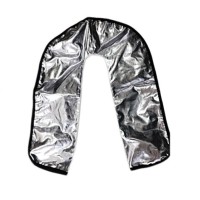The ISO 12402 series for personal flotation devices (lifejackets and buoyancy aids) was prepared by the European Committee for Standardization (CEN) Technical Committee CEN/TC 162, Protective clothing including hand and arm protection and lifejackets, in collaboration with Technical Committee ISO/TC 188, Small craft, in accordance with the Agreement on technical cooperation between ISO and CEN (Vienna Agreement).
ISO 12402 consists of the following parts, under the general title Personal Flotation Devices (PFDs):
- Part 2: Lifejackets, performance level 275 — Safety requirements
- Part 3: Lifejackets, performance level 150 — Safety requirements
- Part 4: Lifejackets, performance level 100 — Safety requirements
- Part 5: Buoyancy aids (level 50) — Safety requirements
- Part 6: Special purpose lifejackets and buoyancy aids — Safety requirements and additional test methods
- Part 7: Materials and components — Safety requirements and test methods
- Part 8: Accessories — Safety requirements and test methods
- Part 9: Test methods
The International Organization for Standardization (ISO) is a worldwide federation of national standards bodies (ISO member bodies). The work of preparing International Standards is normally carried out through ISO technical committees. Each member body interested in a subject for which a technical committee has been established has the right to be represented on that committee. International organizations, governmental and non-governmental, in liaison with ISO, also take part in the work. ISO collaborates closely with the International Electrotechnical Commission (IEC) on all matters of electrotechnical standardization. International Standards are drafted in accordance with the rules given in the ISO/IEC Directives, Part 2.
WSH Alert Accident Notification, 26 February 2021: Worker fell off pilot ladder into sea
|
The industry is reminded to conduct a comprehensive Risk Assessment for all work activities related to vessel embarkation and disembarkation. Precautions must be taken to prevent workers from falling into water. Where possible, always select a safer method (e.g. use of vessel gangways) for embarkation or disembarkation. If pilot ladders must be used, ensure workers are physically fit for the task and sufficiently confident before allowing them to proceed. Safe Work Procedures must be established to guide workers on the safe use of pilot ladders. Employers of workers exposed to the risk of falling into water must provide suitable life vest to keep the workers afloat in the event they fall into the water. Workers should be trained on the importance and correct manner of donning the life vest. Instruct workers not to attempt embarking or disembarking a vessel when conditions are not favourable (e.g. heavy rain, strong winds and/or choppy waters). If conditions are good, then embarking/disembarking may proceed only when the passenger launch is in position. |
WSH Alert, 4 July 2022 [Fatal Accident] Worker fell into sea while boarding service boat
Recommendations |
Falling overboard can happen during vessel transfers. Personnel involved must be made aware of the risks and exercise good situational awareness. To prevent similar accidents, consider the following measures: |
● Pre-transfer briefing: Prior to vessel transfer, brief workers on the safe method of transfer (e.g. gangway and/or pilot ladder), onsite hazards, and personal protective equipment (e.g. helmet, life jacket, gloves, safety boots) to be used. ● Safe transfer condition: Do not proceed with vessel transfer if there are unfavourable weather or sea conditions, extensive vessel or boat movement, if anyone feels unwell or if it feels unsafe to proceed. |
● Life jackets: For safe boarding of vessels, the Maritime and Port Authority of Singapore recommends the use of SOLAS type-approved life jacket or a life jacket meeting ISO 12402 Personal Flotation Devices with performance level 100 or higher. Always check that life jackets are in good condition before use. ● Equipment transfer: Pack all belongings, loose items and equipment into bags and separately transfer them onto the vessel. ● Safe vessel transfer: Boarding area of service boats should not have slip or trip hazards, have sufficient handholds, and be within the line-of-sight of the boat operator. Board only when the gangway is level with the service boat and in the direction of the boat master. ● Transfer supervision: Deploy a deckhand on the service boat and a gangway watch on the vessel to supervise and assist workers during vessel transfer, and to activate emergency response and rescue procedures as required.
|

_www.noah.com.sg-375x250.jpg)



